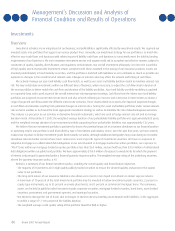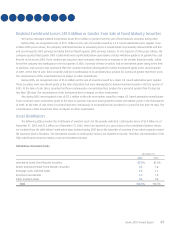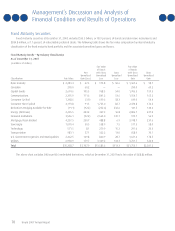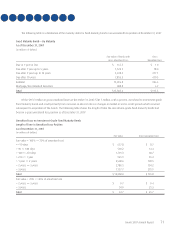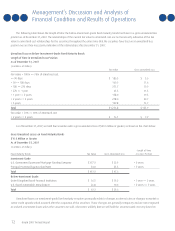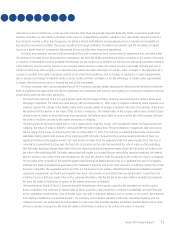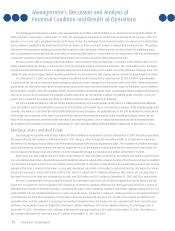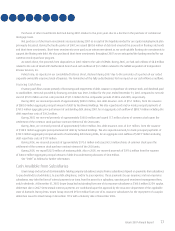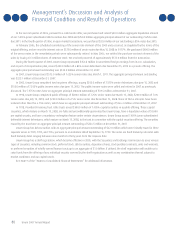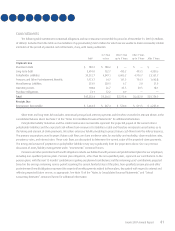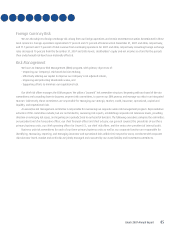Unum 2007 Annual Report Download - page 77
Download and view the complete annual report
Please find page 77 of the 2007 Unum annual report below. You can navigate through the pages in the report by either clicking on the pages listed below, or by using the keyword search tool below to find specific information within the annual report.
Unum 2007 Annual Report 75
Derivatives
We use derivative financial instruments to manage reinvestment risk, duration, and currency risk. Historically, we have utilized interest
rate futures contracts, current and forward interest rate swaps and options on forward interest rate swaps, current and forward currency
swaps, interest rate forward contracts, forward treasury locks, currency forward contracts, and forward contracts on specific fixed income
securities. All of these freestanding derivative transactions are hedging in nature and not speculative. Positions under our hedging programs
for derivative activity that were open during 2007 involved current and forward interest rate swaps, current and forward currency swaps,
currency forward contracts, forward treasury locks, and options on forward interest rate swaps. Almost all hedging transactions are
associated with the individual and group long-term care and the individual and group disability products. All other product portfolios are
periodically reviewed to determine if hedging strategies would be appropriate for risk management purposes.
Our current credit exposure on derivatives, which is limited to the value of those contracts in a net gain position less collateral held,
was $47.9 million at December 31, 2007. The carrying value of fixed maturity securities pledged as collateral to our counterparties was
$265.8 million at December 31, 2007. See Note 5 of the “Notes to Consolidated Financial Statements” for additional information.
Other
Our exposure to non-current investments, on a fair value basis, totaled $2.6 million at December 31, 2007, compared to $12.5 million
at December 31, 2006.
We have an investment program where we simultaneously enter into repurchase agreement transactions and reverse repurchase
agreement transactions with the same party. We net the related receivables and payables in the consolidated balance sheets since these
transactions meet the requirements for the right of offset. We did not have any of these agreements in an open position at December 31,
2007. We also use the repurchase agreement market as a source of short-term financing, but had no contracts for this purpose
outstanding at December 31, 2007.
Liquidity and Capital Resources
Our liquidity requirements are met primarily by cash flows provided from operations, principally in our insurance subsidiaries. Premium
and investment income, as well as maturities and sales of invested assets, provide the primary sources of cash. Debt and/or securities
offerings provide an additional source of liquidity. Cash is applied to the payment of policy benefits, costs of acquiring new business
(principally commissions), operating expenses, and taxes, as well as purchases of new investments. We have established an investment
strategy that we believe will provide for adequate cash flows from operations.
Our policy benefits are primarily in the form of claim payments, and we have minimal exposure to the policy withdrawal risk associated
with deposit products such as individual life policies or annuities. A decrease in demand for our insurance products or an increase in the
incidence of new claims or the duration of existing claims could negatively impact our cash flows from operations. Deterioration in the
credit market, which could delay our ability to sell our positions in certain of our fixed maturity securities in a timely manner, could also
negatively impact our cash flows. We believe our cash resources are sufficient to meet our liquidity requirements for the next 12 months.
During 2007, our board of directors authorized the repurchase of up to $700.0 million of Unum Group’s common stock. The share
repurchase program does not have an expiration date, and the pace of repurchase activity will depend upon various factors such as the
level of available cash, alternative uses for cash, and our stock price. The authorization may be modified, extended, or terminated by our
board of directors at any time.
During January 2008, we repurchased approximately $350.0 million of our outstanding common stock, pursuant to the share repurchase
authorization, using an accelerated share repurchase agreement. Under the terms of the repurchase agreement, we may receive, or be
required to pay, a price adjustment based on the volume weighted average price of our common stock during the term of the agreement.
Any price adjustment payable to us will be settled in shares of our common stock. Any price adjustment we are required to pay will be
settled, at our option, in either cash or common stock. We expect the price adjustment to settle on or before the completion of the
agreement in May 2008.



